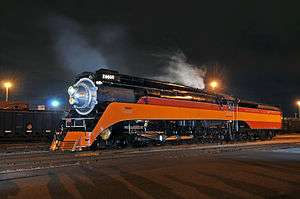Southern Pacific class GS-4
The GS-4 is a streamlined 4-8-4 Northern type steam locomotive used on the Southern Pacific Company from 1941 to 1958. They were built by the Lima Locomotive Works and were numbered 4430 through 4457. "GS" stands for "Golden State" or "General Service."
| Southern Pacific GS-4 | |||||||||||||||||||||||||||||||||||||||||||||||
|---|---|---|---|---|---|---|---|---|---|---|---|---|---|---|---|---|---|---|---|---|---|---|---|---|---|---|---|---|---|---|---|---|---|---|---|---|---|---|---|---|---|---|---|---|---|---|---|
 SP 4449, the youngest (and sole-remaining) GS-4 locomotive, under steam in Tacoma, WA in June, 2011. | |||||||||||||||||||||||||||||||||||||||||||||||
| |||||||||||||||||||||||||||||||||||||||||||||||
| |||||||||||||||||||||||||||||||||||||||||||||||
| |||||||||||||||||||||||||||||||||||||||||||||||
| |||||||||||||||||||||||||||||||||||||||||||||||
History
Unlike the GS-3, the GS-4 had a dual-headlight casing (top headlight was a mars light) on the silver smokebox. Another change was the all-weather cab. It retained the skyline casing atop of the boiler, skirting on the sides, an air horn to supplement the whistle and teardrop classification lights. They carried the orange and red "Daylight" paint scheme.
The GS-4s were passenger engines capable of 110 mph (180 km/h), though timetable speed limit never exceeded 75 mph or 121 km/h. Southern Pacific's premier passenger trains were pulled by GS-4s, the Coast Daylight, San Joaquin Daylight, Lark, Cascade, Golden State and Sunset Limited. During wartime and in the first years after the war some of the GS-4 locomotives were painted black; by 1948 all had been repainted into Daylight colors. Starting in 1947 most were painted black again and had their side skirts removed for easier maintenance, and were reassigned to the San Jose-San Francisco commuter trains, freight service and the occasional San Joaquin Daylight (steam locomotives remained on that train as late as 1956 which made the San Joaquin Daylight the last streamliner train to be pulled by steam on the Southern Pacific) until new diesels arrived and they were retired. The last GS-4 engines were deskirted and painted black in 1956; a GS-4 pulled its last passenger train in October 1958. All were retired by 1958. GS-4 number 4443 pulled one of the final steam excursions on the Southern Pacific in 1957, and appeared in the opening credits of the Frank Sinatra film Pal Joey. SP 4449 (Southern Pacific 4449) appeared in the 1986 movie Tough Guys as the Gold Coast Flyer. In the screenplay, the 4449 was hijacked, and then crashed through the Mexican border in the movie; however, a wooden and fabric full-size scale model was used to depict the crash. The actual SP 4449 was returned unscathed to the private group that owned it. An unknown GS-4 appeared in the movie Dear Heart as the 20th Century Limited, and another GS-4 appeared as the main setting for Strangers on a Train.
Preservation
Southern Pacific 4449 is the only surviving GS-4 locomotive and is one of the most recognizable locomotives of all time. She was donated to the City of Portland in 1958 and moved to Oaks Amusement Park for static display until December of 1974 when the locomotive was removed from the park to undergo restoration. From August 1975 to December 1976, 4449 shared duties with several other steam locomotives pulling the American Freedom Train throughout the U.S. 4449 is still operational and since mid-2012 resides at the Oregon Rail Heritage Center in Portland along with other preserved locomotives and rolling stock.
The tender of SP 4444 (the last GS-4 to be scrapped) was rebuilt by SP and used as a "hammer car" to test impacts on hydracushion boxcars; it was scrapped in the early 1970s.
References
- Church, Robert J. (2004). Southern Pacific Daylight Locomotives (1st ed.). Signature Press. ISBN 1-930013-11-6.CS1 maint: ref=harv (link)
- Diebert, Timothy S. & Strapac, Joseph A. (1987). Southern Pacific Company Steam Locomotive Compendium. Shade Tree Books. ISBN 0-930742-12-5.
- The American Freedom Train Foundation (1975). The American Freedom Train Official Commemorative Program 1975 / 1976. The American Freedom Train Foundation.